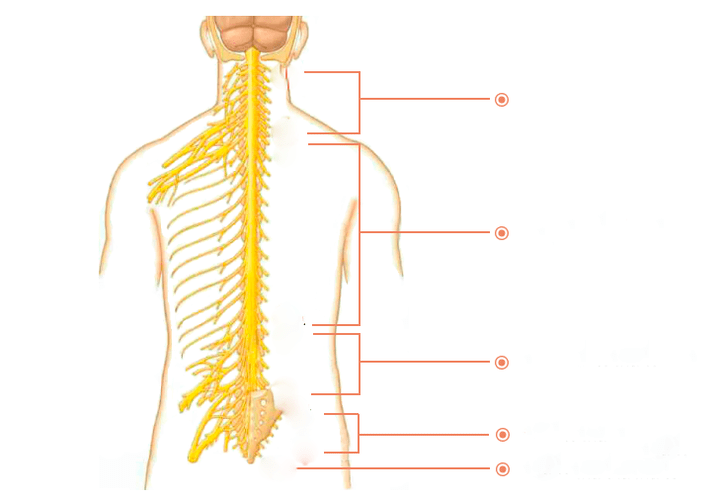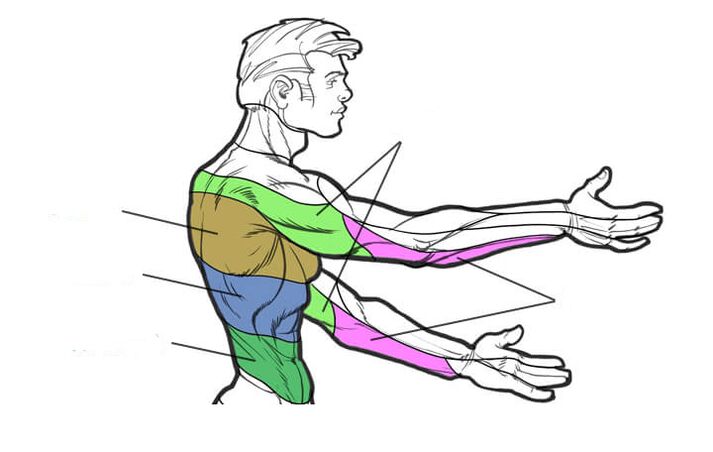The thoracic spine has a special feature - its ribs join. This makes it less mobile than the neck and lower back. Consequently, osteochondrosis in the thoracic region develops less frequently, on the principle: "less mobility - less wear". But it develops less often - that doesn’t mean it flows easier. And it really is. It's about chest pain. Because the painful area of the thoracic spine coincides with the area of the heart, the symptoms are often confused with angina pectoris or myocardial infarction. No wonder thoracic osteochondrosis is said to be a "chameleon". After all, it can pretend not only to have heart disease, but also disease of the lungs, liver, stomach, gallbladder or pancreas. Here, too, you cannot go wrong and overlook a heart attack or some other serious illness, for example, mammary gland pathology in women. Mistakes like this are costly, even if they end up. After all, it can "force" a person into serious stress. That is why it is very important to find an experienced and educated doctor who will understand everything and distinguish the symptoms of thoracic osteochondrosis from other pathologies. Symptoms of osteochondrosis of the thoracic region are usually divided into two categories - radicular and reflex.
Radicular symptoms
They are caused by the effect on the nerves that come out of the spine.
spinal nerves

A lot of nerves come out of the spine. They are called spinal nerves. Each such nerve gradually branches and follows a specific part of the body with clearly defined boundaries. This area is called the segmental innervation zone. Each vertebra, disc, nerve and zone are numbered strictly with each other. If the nerve is affected, the symptoms will appear in the zone of segmental innervation that corresponds to this nerve, and not anywhere - in any place.
Radical symptoms include:
- Reduction or loss of reflexes;
- Violation of sensitivity;
- muscle weakness;
- Heart pain.
Zones of innervation of thoracic segments
Osteochondrosis D1 – D2- causes pain in the shoulder, collarbone and armpit.

Osteochondrosis D3 – D6- Causes pain, lumbar in the upper part of the chest. Simulates heart pain, angina pectoris attack. In women, it causes pain in the mammary glands.
Osteochondrosis D7 – D8- causes belt pain at the level of the solar plexus. Simulates pain in the stomach, liver, gallbladder or pancreas. It reduces the reflexes of the upper abdomen.
Osteochondrosis D9 – D10- causes pain in the hypochondrium and upper abdomen. Sometimes it mimics the so-called "acute" abdomen - a sharp pain in the abdomen. Reduces the reflexes of the middle abdomen.
Osteochondrosis D11 – D12- causes pain in the groin area. Simulates pain in women's diseases, appendicitis, intestinal diseases. It reduces the reflexes of the lower abdomen.
Reflex symptoms
Unlike radicular, reflex symptoms have no clear boundaries. These can be: shortness of breath, shortness of breath, pain on inhalation-exhalation, shivering and "shivering" on the skin, intercostal neuralgia, chest pain in the chest. Dyspepsia is often observed - appetite worsens, nausea, heartburn, bloating andstool disorder Pain leads to sleep disturbances, insomnia and feeling that you have not slept enough It is difficult to move, especially in the morning Movement coordination is impaired - this is reflected in gait General weakness, weakness Sexual disorders IrritabilityRapid fatigue There are different types of pain Pressure chest pain Pain between the shoulder blades Pain in the hypochondrium Pain when raising the arms Pain when bending or trying to straighten Pain between the shoulder blades In general, pain in osteochondrosis of the thoracic region can be divided into twospecies.
Dorsalgia- moderately pronounced prolonged pain in the back and chest with periods of strengthening and weakening.
Dorsago- acute lumbago pain in this area.
- The symptoms of thoracic osteochondrosis depend on the stage of osteochondrosis.
- They are amplified by squatting or trying to stand up straight.
- Symptoms often appear after 35-45 years.
- It occurs about 3 times more often in women than in men.
You have, of course, noticed that the radicular symptoms are clearly defined and the reflex symptoms very vague and nonspecific. And as you know, anything that doesn't have a clear definition serves as a convenient cover for professional helplessness. This, among other things, refers to reflex symptoms and such a favorite concept among doctors as "age-related changes. " Many of you are probably familiar with the situation when a doctor explained the problem by "reflex" or "age" processes. At such moments, he rightly believes that the doctor simply cannot understand what is happening and tries to hide his inability in the fog of these "magic words".
It used to be a popular phrase: "Every accident has a name, surname and position. " Every disease has its own unique symptoms. And the doctor's duty is to know them clearly. And then there will be no need to let yourself in the fog and blame osteochondrosis of the thoracic region for everything. Now you understand how important it is to find an experienced and educated doctor. Proper diagnosis and good treatment results will depend on this.
Diagnosis is the key to proper treatment
To date, there are a number of modern methods of hardware diagnosis of osteochondrosis. The most accurate of these are MRI and CT. But the main method is still clinical diagnosis - that is, when an experienced doctor compares data from at least three sources - from patient complaints, MRI results and symptoms he discovered during the examination. This allows you to make the most accurate diagnosis and create an effective individual treatment program.
Treatment
As you can see, osteochondrosis is a real "tangle" of symptoms, unraveling which, the doctor will save you from pain and anxiety. But it is not possible to eliminate changes in the vertebrae and discs. Therefore, the words "treatment of osteochondrosis" must be properly understood. If you are interested in eliminating pain and other suffering, then yes - it is quite possible. And if you are having an academic discussion on returning vertebrae and discs to their original appearance, "like a newborn", then no, the past cannot be returned. You have to be realistic and then you will not fall for the bait of a fraudster.
Don't fall for the bait of a scammer!
It is impossible to return the vertebrae and discs to their original appearance!
What is the main method of treatment?
Soft manual therapy is the main type of treatment for osteochondrosis of the thoracic region. It's like an antibiotic for pneumonia - you can't do without it. Other types - massage, medication, physiotherapy and exercise therapy - are helpful.
How does gentle manual therapy work?
The nutrition of the discs is directly related to the muscles that surround the spine. In addition, the back muscles themselves are one of the constitutive causes of pain in osteochondrosis of the thoracic region. Soft manual therapy is a special method that allows you to return the muscles to their natural physiology, eliminate cramps, tighten muscles and improve disc nutrition.
Intervertebral discs are the only part of the body that does not have blood vessels and that feeds on proper muscle function.
In addition, when treating with the help of the hands, the chiropractor:
- remove the load from the affected vertebrae and discs and distribute it properly;
- relax the muscles and help them return to normal;
in that way:
- save the patient from clamps;
- improve disk power;
- restoration of motor functions of the body;
- normalizes blood circulation.
The hand strike mobilizes the internal forces of the body and triggers the mechanisms of self-healing.
The treatment is absolutely safe.
Prevention
To avoid recurrences, create comfortable conditions for sleeping and working. Take care of your weight and proper diet. Maintain your physical activity. But the main thing is not to neglect your health and do not skimp on it. Don't let things go by themselves. After recovery, try to do at least one session of gentle manual therapy once every three to six months - this will reduce risk factors. Remember, neglected osteochondrosis leads to complications - protrusions and disc herniation. Remember: your health, above all, you need!
Running osteochondrosis leads to complications - protrusion and disc herniation.













































